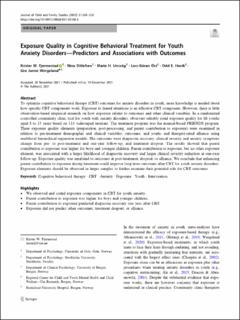| dc.contributor.author | Fjermestad, Krister Westlye | |
| dc.contributor.author | Ditlefsen, Nina | |
| dc.contributor.author | Unsvåg, Marie H. | |
| dc.contributor.author | Öst, Lars Gøran | |
| dc.contributor.author | Havik, Odd E. | |
| dc.contributor.author | Wergeland, Gro Janne Henningsen | |
| dc.date.accessioned | 2022-04-22T13:26:49Z | |
| dc.date.available | 2022-04-22T13:26:49Z | |
| dc.date.created | 2022-01-18T21:03:50Z | |
| dc.date.issued | 2022 | |
| dc.identifier.issn | 1062-1024 | |
| dc.identifier.uri | https://hdl.handle.net/11250/2992336 | |
| dc.description.abstract | To optimize cognitive behavioral therapy (CBT) outcomes for anxiety disorders in youth, more knowledge is needed about how specific CBT components work. Exposure to feared situations is an effective CBT component. However, there is little observation-based empirical research on how exposure relates to outcomes and other clinical variables. In a randomized controlled community clinic trial for youth with anxiety disorders, observers reliably rated exposure quality for 68 youths aged 8 to 15 years based on 118 videotaped sessions. The treatment program was the manual-based FRIENDS program. Three exposure quality elements (preparation, post-processing, and parent contribution to exposure) were examined in relation to pre-treatment demographic and clinical variables, outcomes, and youth- and therapist-rated alliance using multilevel hierarchical regression models. The outcomes were diagnostic recovery, clinical severity and anxiety symptoms change from pre- to post-treatment and one-year follow-up, and treatment dropout. The results showed that parent contribution to exposure was higher for boys and younger children. Parent contribution to exposure, but no other exposure element, was associated with a larger likelihood of diagnostic recovery and larger clinical severity reduction at one-year follow-up. Exposure quality was unrelated to outcomes at post-treatment, dropout, or alliance. We conclude that enhancing parent contribution to exposure during treatment could improve long-term outcomes after CBT for youth anxiety disorders. Exposure elements should be observed in larger samples to further examine their potential role for CBT outcomes. | en_US |
| dc.language.iso | eng | en_US |
| dc.publisher | Springer | en_US |
| dc.rights | Navngivelse 4.0 Internasjonal | * |
| dc.rights.uri | http://creativecommons.org/licenses/by/4.0/deed.no | * |
| dc.title | Exposure Quality in Cognitive Behavioral Treatment for Youth Anxiety Disorders—Predictors and Associations with Outcomes | en_US |
| dc.type | Journal article | en_US |
| dc.type | Peer reviewed | en_US |
| dc.description.version | publishedVersion | en_US |
| dc.rights.holder | Copyright The Author(s) 2021 | en_US |
| cristin.ispublished | true | |
| cristin.fulltext | original | |
| cristin.qualitycode | 1 | |
| dc.identifier.doi | 10.1007/s10826-021-02188-8 | |
| dc.identifier.cristin | 1984180 | |
| dc.source.journal | Journal of Child and Family Studies | en_US |
| dc.source.pagenumber | 308–320 | en_US |
| dc.identifier.citation | Journal of Child and Family Studies. 2022, 31, 308–320. | en_US |
| dc.source.volume | 31 | en_US |

